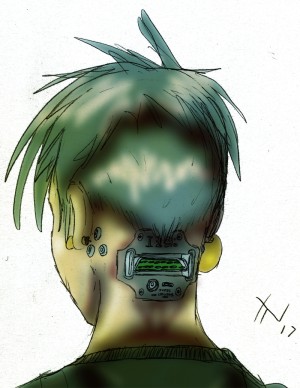Sidebar
Table of Contents
Mindware Technology
This is an article on Freespacer implant hardware and software. For the Nepleslian version, see Nepleslian Mindware.
Mind-Machine Interface
| “Most societies have those who detest seeing machines doing what people once did, both in their homes and at their workplaces. This may be due to the inherent inhumanity of machines; for once they are competently programmed and functioning properly, they are completely honest and loyal.” – Druidess Elnath Five Two 52-8443-1696 The Art of Never Again, Chapter 293: Collected Sermons on Cyberempathy |
The Mind-Machine Interface (or MMI) is precisely what its name suggests, a way for Freespacers and Automata to directly interface their neural network with a computer system or network. In essence the MMI is used as a blanket term used for standardized Freespacer implant technology. Its actually composed of three components; a converter to translate digital and brain signals, a digital memory module, and a co-processor to enhance the performance of the former two and increase cognitive intelligence. The system itself can interface using wireless connections, but high volume data transfers (such as simulated reality) requires a direct interface. This interface can be found either just behind the ear or at the base of the skull, through which data cables can be plugged directly into the cranium.
The MMI is commonly used by Freespacers to access information networks, or in order to directly interface with equipment when working. Since the Freespacers live a very ascetic lifestyle (at least in the physical world), they rely almost completely on the virtual world for leisure and recreation. In this regard the MMI is used to interact with realistic simulated environments commonly used for socialization or games.
Freespacers commonly record their most important memories in digital format, usually in the form of journals, audio recordings, or video files. This is to prevent any risk of forgetting an important memory, and so that when they die their memoirs can be passed on to their successor clone or close friends. However, digital memory is much easier to interpret than the human neural networks, so information stored here can potentially be a prime target for wetware hackers. More so since the host already has a MMI connection already installed.
When interfacing with a system the level of real world awareness depends on the activity in the digital world. For example, simply browsing files and information will usually put the user in an easily interruptible state not unlike a daydream. More complex tasks like operating machinery can reduce awareness level to a light sleep. Realistic simulated environments that take full use of all the human senses and can block out almost all real-world stimuli, save for excessive amounts of pain.
Mindware
| “Imagine the entire contents of a sixteen year long academic program, the sum total of a high-end specialist education, blasted into a child's fragile neural network with the full power of a supercomputer over the course of a week. A lifetime of enlightenment compressed into a single searing burst of revelation. That is our last-ditch attempt to win our species a reprieve from intellectual degeneration at the hands of our short life expectancy. How desperate we have become, how proud.” – Mastermind Kastra Eight Five 85-2183-0430 The Art of Never Again, Chapter 127: Fixing the Human Condition |
Mindware utilizes MMI technology in order to allow a person to assimilate huge quantities of information over a short time. Freespacers have a very short lifespan for a spacefaring sentient species, aging approximately 3.5 years for every human year. Thus an education up to and including university-level at standard speed would take up over four-fifths of their lifespan (once infancy-to-childhood growth is factored in, so they are actually old enough to learn). This has prompted adapt various types of accelerated and sleep learning processes, the most recent and effective of which is Mindware.
Active Instruction
Mindware works by downloading quantities of information into digital memory interfaced with the brain. Information stored in this state is not truly memorized, but acts more along the lines of a computer that can be accessed at will. A user can view an index of files or limited interactive instructions as a mental image, in a way not unlike a daydream.
While this method allows for the storage of huge sums of information, it is much less streamlined than true memorization. For example, if an untrained person with Mindware were told to do an unfamiliar task, they would need to pause what they were doing, search their digital library for the respective file, and go through the slow process of following step-by-step instructions. This would take even longer if a user did not bother to properly memorize their file index, as they would need to mentally search for an article.
Passive Learning
As time passes users become faster and more streamlined regarding the access of information. At first they simply learn how to search faster, but will eventually become familiar with the entire index and gain the ability to skip directly to a specific set of instructions at will. The user will also learn to multitask, reading the next set of instructions while they are still performing a first task. And eventually through sheer repetition may come to 'truly' memorize the instructions, fully integrating them into the conscious mind. The process of memorizing the files themselves is accelerated through hypnopaedia, or sleep-learning, but the entire process of memorizing a full university-level education may still take years.
OOC Notes
This article was created by Strangelove. It was approved by Fred on January 30, 2007: Approval Info
Page Tools
Terms of Service - Privacy Policy

